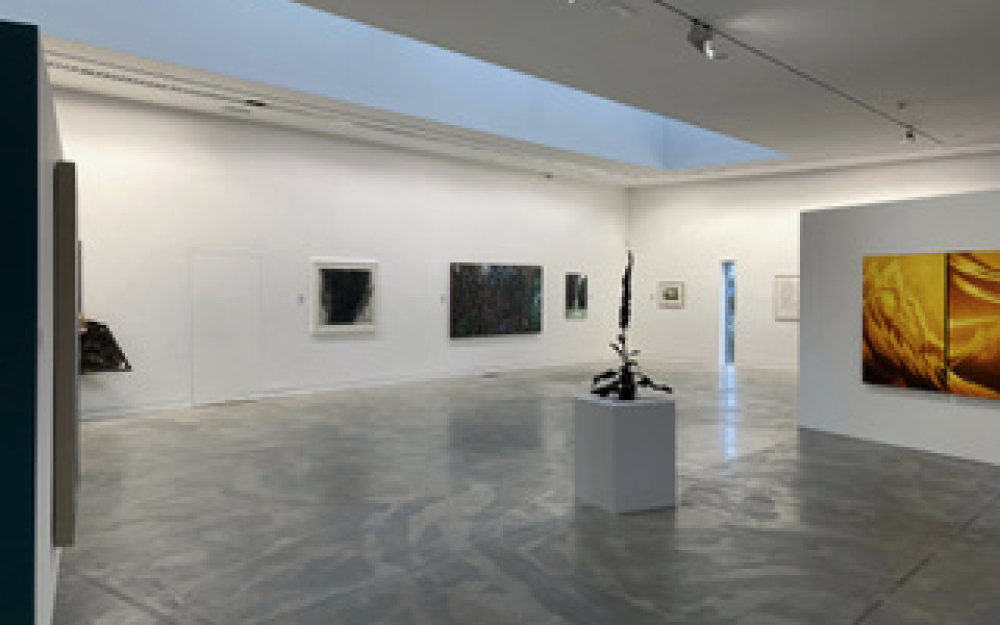The ‘Other Worlds’ exhibition right here on our doorstep in rural Donegal is an accomplished curation of our national collection of art at this moment in time. Both the traditional and the contemporary greatly captivate the senses as one era or art form is allowed to segue into the next, regardless of media, artistic intent, or context, a flow that ties in seamlessly is crafted. I am fascinated by the large-scale piece entitled ‘Breakage’ by visual artist Vera Klute painted in 2020 (Fig.2). It’s an expressive style with intense oil colours on a pure black oil ground depicting a close-up image of an off-the-beaten-path scene densely populated with vegetation. Visible brush marks in hard, soft, curved and jagged lines, guide the eye around the composition. The movement is diagonal, circular and rhythmic, and the painting has a three-dimensional quality. It’s interesting how an appearance of texture was achieved without the use of a thick impasto application.
Fig 2

This artwork resonated with me the most and I instantaneously began sketching it upon having just about grasped the spectacle. That—drawn—reaction is not entirely unusual for me as I can on occasion be found standing sketching in front of the works of great masters at the National Gallery of Ireland in the capital. In this instance, however, I experienced an emotional response to an array of stimuli created by a combination of the format, mark-making, colour characteristics and of course the subject of the pictorial motif which happens to be an enclosed space near a park. The mere act of reactively drawing enabled me to feel my way across and indeed through the extensive composition and also served as a means for me to express myself in some way. The ‘closer’ image, or close-up yielding a wide-angle view, may appear cluttered to some, yet to me it not only affords a full panorama of experience—by way of immersion as a viewer firmly within the scene/environment—it makes the eyes travel about the picture plane thus simulating the effect of actually being in the landscape itself—something that naturally occurs when we are out and about in life. I felt uplifted after the short space of time that I had spent in front of this piece, brought about by its vitality and the enclosed representation of the natural world.



My artistic discourse in landscape painting over the past five years explores a similar effect. Working big, I try to deepen the practice of embracing subjective unconscious feelings about form to get a motif onto the page/panel, and additionally, the making of some marks that transform and articulate its structure, with my hand working at high tension. Yet there is another reason for my affinity with Klute’s artwork featured in this exhibition, that of its subject as the impetus for a response to lockdown. During an unprecedented era of both welfare uncertainty and restrictions on our whereabouts, most of us were presented with our immediate environments, places we might not have previously ventured out to or might not even have noticed. Not for me though, perhaps with the artist in me I have always ventured out into my surroundings. To me, the new vacuum, that strange form of isolation, presented a different scenario, a disconnect from open water swimming with my peers along our wonderful coastlines. This prompted me to produce an artwork depicting what it felt like to be swimming in mass within a big ocean swell—a simultaneously expansive and enclosed space—having enjoyed this activity only a few months prior. That piece ‘Winter Swimmers, Cuan na gCaorach’ (Fig.7) was featured in the travelling exhibition ‘Dath an Dóchais’ (The Colour of Hope) 2021-22. Like Klute, a wide close-up approach was taken albeit painted light to dark. Similarly, during the summer of 2019, I produced a massive drawing of Drogheda town from the elevated vantage of the adjacent train line—on a 150x300cm sheet of Fabriano paper—depicting the experience of passing by the scene, using a moving focus as a device for the effect (Fig.8). These are just some of the things that excited me about Klute’s artwork, the ‘felt sense’ seen and experienced, mirroring to some extent my work in landscape and memories of simply being in the natural environment.
Fig 7

Fig 8

Our national collection of art is quite diverse and there are many reasons why we the people can benefit from engaging with such. First of all, it represents some of the finest moments of art-making in Ireland. Secondly, as spectators, we are confronted with ‘the other,’ that unthinkable thing that is not us, and perhaps our existence as subjects. This encourages us to look outward. Thirdly, the perspectives generated in art don’t just describe a world which already exists, they construct a world for the viewer—becoming a mode of knowledge—that points to the natural environment as well as our lives. Lastly, the contemporary gallery scene in Donegal offers views of our world, here and beyond (Fig.9).
Fig 9

instagram.com/karo1smg
Several of my works are currently on display at Leabharlann Phobail Ghaoth Dobhair until the end of January.
